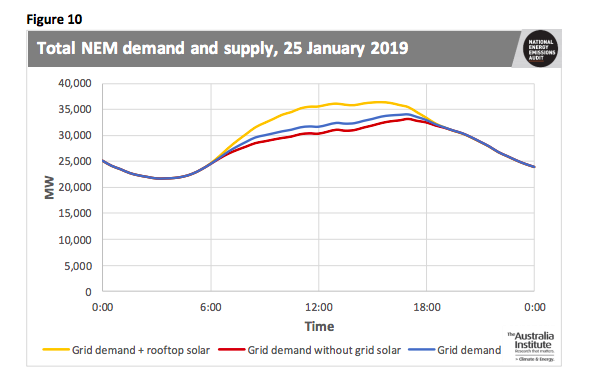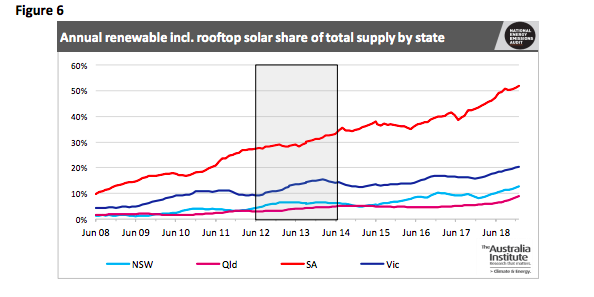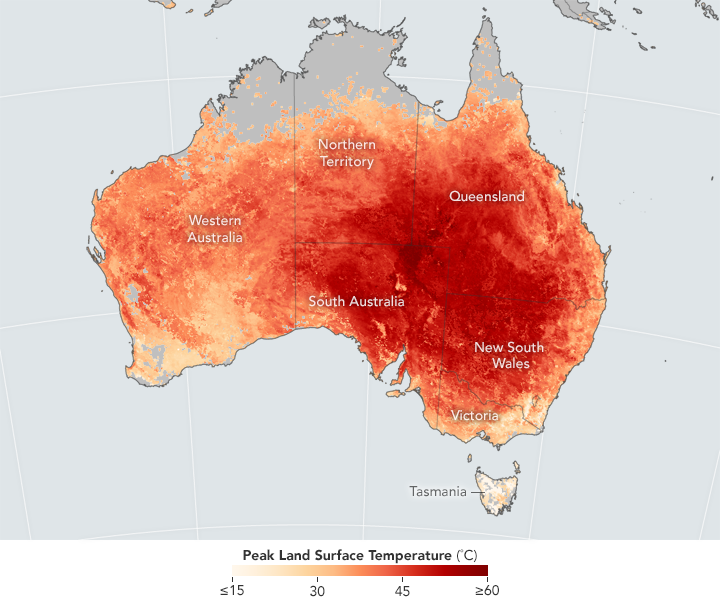While unreliability of ageing coal clunkers was the reason behind the need for AEMO’s intervention during January’s heatwave, the situation could have been much worse without the contributions of rooftop and large-scale solar, finds The Australia Institute (TAI) in its latest report.
Focusing on the role of renewables during January 25 blackout when Victoria’s brown coal generators failed in the heat, TAI’s National Energy Emissions Audit for the month of January shows the grid connected solar farms, although still in their relative infancy, contributed almost 4% of total supply at the time of peak consumption.
While one of the highest-ever total NEM trading (30-minute) interval demand levels of 33,950MW was seen at 6 p.m. AEST, the contribution of rooftop solar, occurred an hour and a half earlier, and, at about 36,410 MW, was nearly 700 MW higher than the previously highest ever grid demand, which occurred at the end of January 2009 when there was negligible rooftop solar capacity.

“If we take one lesson from the record breaking heatwaves this summer, it is that solar saved the day. Both home and large scale solar delaying and diminishing peak electricity demand,” says Hugh Saddler, energy expert and author of the report.
“During the unprecedented heatwave on January 25th large scale solar farms were running at 93 % of their maximum output, which is in stark contrast to Victoria’s brown coal generators of which two of the three stations were operating well below capacity.”
Patchy reliability of coal-fired power generators is old news. In its 2018 Electricity Statement of Opportunities, AEMO warned of a heightened risk of power failure during summer peak-demand periods, based on reduced reliability of ageing fossil fuel generators.
To avoid a blackout scenario, the market operator sourced up to 930 MW of additional reserves under the Reliability and Emergency Reserve Trader (RERT) mechanism, which allows it to pay major energy users to power down or retailers and distributors to reduce customer loads to support the grid.
However, as some 1,800 MW of power capacity in Victoria – two units at EnergyAustralia’s Yallourn and one at AGL Energy’s Loy Yang tripped – the reserves were not enough and electricity spot prices went through the roof reaching the price cap of $14,500/MWh.
With the price cap also reached in SA, AEMO called on the RERT mechanism, turning to the state’s fleet of diesel generators for the first time since they were installed following the state-wide blackout in 2016. As Adelaide recorded its hottest ever day – 46.6 degrees Celsius – almost 30,000 households lost power after transformers on local power lines overheated and switched off.
“The era of coal is ending in Australia and around the world. Renewables are being backed as the most affordable, reliable and popular energy solution — despite the federal government’s efforts to the contrary, Saddler adds.
“The continued growth of solar and wind energy on the NEM, which now exceeds hydro energy, will do far more to reduce emissions than the drop in the bucket that is the Government’s so-called Climate Solutions Fund.”
Other findings
The report also reminds that total renewable generation now supplies more than 20% of total generation in the NEM, a share which is undoubtably going to keep growing. Meanwhile, wind and grid scale solar have exceeded hydro’s share of annual grid generation — a relationship which is also most unlikely to be reversed, with a doubling in large scale wind and solar to be expected by 2021.
On the state level, South Australia is now firmly above 50% renewable electricity, while Victoria passed 20% for the first time in November. In New South Wales, notwithstanding the absence of a formal state government target for renewable generation, the renewable share of annual generation passed 10% last June, and has now reached 12%, the report states. In Queensland, the annual renewable share passed 8% in the year to January, up from 6% just seven months ago, and the rate of growth is accelerating.

This content is protected by copyright and may not be reused. If you want to cooperate with us and would like to reuse some of our content, please contact: editors@pv-magazine.com.









1 comment
By submitting this form you agree to pv magazine using your data for the purposes of publishing your comment.
Your personal data will only be disclosed or otherwise transmitted to third parties for the purposes of spam filtering or if this is necessary for technical maintenance of the website. Any other transfer to third parties will not take place unless this is justified on the basis of applicable data protection regulations or if pv magazine is legally obliged to do so.
You may revoke this consent at any time with effect for the future, in which case your personal data will be deleted immediately. Otherwise, your data will be deleted if pv magazine has processed your request or the purpose of data storage is fulfilled.
Further information on data privacy can be found in our Data Protection Policy.